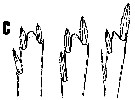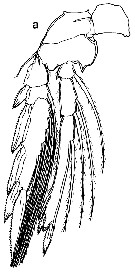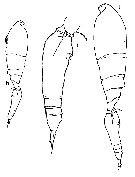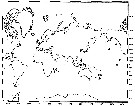|
|
 |
|
Cyclopoida ( Order ) |
|
|
|
Oncaeidae ( Family ) |
|
|
|
Triconia ( Genus ) |
|
|
| |
Triconia derivata (Heron & Bradford-Grieve, 1995) (F,M) | |
| | | | | | | Syn.: | Oncaea conifera : Moulton, 1973 (p.142 & suiv.: 'bumped' form);
Oncaea derivata Heron & Bradford-Grieve, 1995 (p.25, Descr.F, figs.F); Heron & Frost, 2000 (p.1028, Descr.M, figs.F,M, tab.2, 3) | | | | Ref.: | | | Böttger-Schnack, 1999 (p.43, Rem.) |  issued from : G.A. Heron & B.W. Frost in Proc. Biol. Soc. Washington, 2000, 113 (4). [p.1031, Fig.8]. As Oncaea derivata. Male (from NE Pacific): F-G, habitus (dorsal and lateral, respectively; scale bar: t); H, left Mxp (scale bar: x); I, pediger 4 posterior corner and segment of P5 (scale bar: x). Scale bars: 0.1 mm, see figures 3, 4, 5, 10 of Heron and Frost, 2000 for Oncaea canadensis and Oncaea insolita. Nota: Body with scattered refractile points, usually associated with pores. Prosome length about twice that of urosome. Cephalosome with posterolateral double slanting rows of hooded pores (pattern slightly variable). Pediger 4 with acute angle of lateroposterior corner often tilted ventrally. P5 short, not delimited from thoracic segment; shorter terminal seta about 3/5 the length of the longer; outer basal seta. P6 represented by posterolateral point-tipped flap on ventral surface of genital segment.
|
 issued from : G.A. Heron & B.W. Frost in Proc. Biol. Soc. Washington, 2000, 113 (4). [p.1021, Fig.1, C]. As Oncaea derivata. Female: P2-P4 endopod terminal ''spine set'' (combination of the lengths, shapes, and position of the three or two terminal spines on the endopods of swimming legs 2-4 for different Oncaea' species). Nota: endopods of P2 and P3 with lateral spines extending only to base of subterminal spine barely extending beyond distal margin of cone.
|
 issued from : G.A. Heron & J.M. Bradford-Grieve in New Zealand Oceanogr. Inst. Memoir 104. NIWA, 1995. [p.28, Fig.10]. As Oncaea derivata. Female: a, habitus (dorsal) [x]; b, urosome (dorsal) [r]; c, right A1 [s]; d, left A2 [s]; e, labrum (ventral) [u]; f, left Md [t]; g, left Mx1 [t]; h, right Mx2 [t]; i, left Mxp [s]. All scales in p.13, Fig.2. Letter in brackets. Nota: Labrum posteriorly protuberant, free margin divided into 2 posteroventral lobes, each with a row of dentiform setules inserted on under surface; several layers of thin median lamellae extend posteriorlty between lobes; spiniform circular protuberance with posterior setules, anterior to vertex of labrum; lateral setules.
|
 issued from : G.A. Heron & J.M. Bradford-Grieve in New Zealand Oceanogr. Inst. memoir 104. NIWA, 1995. [p.30, Fig.11, a]. As Oncaea derivata. Female: a, P4 [s]. Scale in p.13, Fig.2. Letter in brackets.
|
 issued from : G.A. Heron & J.M. Bradford-Grieve in New Zealand Oceanogr. Inst. memoir 104. NIWA, 1995. [p.27, Fig.9, h-j]. As Oncaea derivata. Female (from 30°45'S, 173°16'E): h, habitus (lateral) [q]; i, urosome (lateral) [s]; j, habitus (lateral) [r] (from Panama Basin). Scale in p.13, Fig.2. Letter in brackets. Nota: Prosome length to that of urosome 1.7:1. Cephalosome length about equal to that of remaining segments of prosome, as well as to that of genital segment plus succeeding segments of urosome. 5th segment with lateroposterior corner uneven. Urosome first segment with faint trnsverse sclerotized line dorsoposteriorly. Genital segment length more than double the width and about equal to total length of three posterior segments of prosome; gonopore located on posterior margin of anterior third of dorsal surface, with 1 setule. Caudal ramus about twice as long as wide. The species has a propensity for developing a tumorous growth on the mid-dorsal surface of the cephalosome (fig.h). The growth appears to be associated with pores; the copepod has probably endured the abnormality since before at least the last moult because chitin has grown in irregular folds to cover the expansion.
| | | | | Compl. Ref.: | | | Nishibe & al., 2009 (p.491, Table 1: seasonal abundance) | | | | NZ: | 6 | | |
|
Distribution map of Triconia derivata by geographical zones
|
| | |  issued from : G.A. Heron & B.W. Frost in Proc. Biol. Soc. Washington, 2000, 113 (4). [p.1060, Fig.24]. issued from : G.A. Heron & B.W. Frost in Proc. Biol. Soc. Washington, 2000, 113 (4). [p.1060, Fig.24].
Locality records for selected species of Oncaea derivata (= Triconia derivata).
Records include previously published personal observations and data presented in this study (p.1023, Table 3) |
| | | | Loc: | | | Liberia, Florida, Tasman Sea, off N New Zealand, Panama Basin, NE Pacif. (Strait of Juan de Fuca), Japan (Tosa Bay, Kuroshio region) | | | | N: | 4 | | | | Lg.: | | | (681) F: 1,22-1,11; (838) F: 1,05-1,15; M: 0,67-0,74; {F: 1,05-1,22; M: 0,67-0,74} | | | | Rem.: | Mesopelagic.
Heron & Frost (2000, p.1017) do not agree that the generic definition of Triconia by Böttger-Schnack (1999) is sufficient to justify inclusion of all of the divergent species she assigned to the new genus.
For Heron & Bradford-Grieve (1995, p.29) this species closely resemble T. furcula. | | | Last update : 02/02/2015 | |
|
|
 Any use of this site for a publication will be mentioned with the following reference : Any use of this site for a publication will be mentioned with the following reference :
Razouls C., Desreumaux N., Kouwenberg J. and de Bovée F., 2005-2025. - Biodiversity of Marine Planktonic Copepods (morphology, geographical distribution and biological data). Sorbonne University, CNRS. Available at http://copepodes.obs-banyuls.fr/en [Accessed December 27, 2025] © copyright 2005-2025 Sorbonne University, CNRS
|
|
 |
 |









